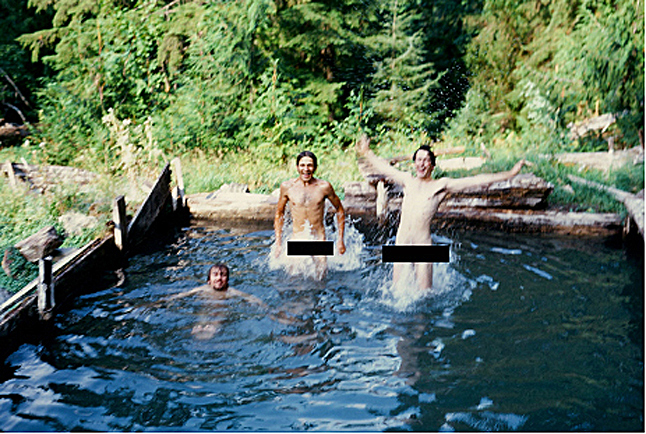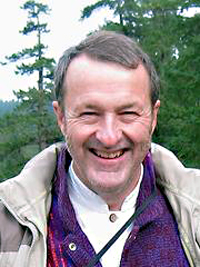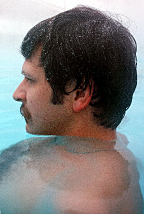

I’m prone to repeating a piece of lore published in Tom Robbins’ 1984 novel, Jitterbug Perfume. In it, he reveals the long-sought answer to eternal life: simple eating, sex, and bathing in extremely hot water. Since I enjoy B.C.’s hot springs very much, the advice is rather easy to follow. I’ve been visiting both natural and developed springs around the province since growing up in Revelstoke, and have had interesting experiences in those scattered around the Kootenays in particular.
Many Revelstokians had summer cabins at the former resort of St. Leon on the lower Arrow Lake. In the latter days of its existence, they included the Joris & Mary Daem family, the Sinc & Muriel Jones family, plus Harry & Nancy Knight and their two girls. The grand hotel that opened there in 1902 still existed when B.C. Hydro bought it in advance of raising the lake with Hugh Keenleyside Dam in 1968. The raison d’ être of the hotel was the hot springs several kilometers up St. Leon Creek (where they can still be visited in the bush). However, as a spa, St. Leon was overtaken by the development of Halcyon Hot Springs, further north on the same shore. Both claimed curative powers, which was common in those days of quack medicine. Elsewhere, I still recall a collection of abandoned canes and crutches in some dusty corner at a hot spring which I visited as a boy — a form of advertising.
Ainsworth Hot Springs
This privately developed spring lies on the western shore of Kootenay Lake about 46 km north of Nelson. Set amidst lovely scenery, its main feature is a horseshoe-shaped cavern which enters and exits the mountainside at the same spot—immediately adjacent to the warm pool filled with loungers. The hot (45º C.) water issues from crevices in the ceiling and fills the cavern with steam. The passage floor is level concrete, but the walls of rock are covered with layers of smooth, white calcite. The chambers are partially illuminated, but there are several dim recesses where you can sit on ledge and neck with your lover. Voices echo as within a cathedral, and even my voice sounds like the entire Red Army Chorus. Next time you’re there, try a basso chorus from Volga Boatmen!
Visiting here for the first time as a kid, I refused to enter the cave because, deep in the mountain, I’d caught glimpse of an old Doukhobor with a long white beard. With swirling vapours and poor light partially obscuring him, he looked like a Methuselah of the mountain. Perhaps, if a Robbins disciple, he was onto something, but I’ve never met him since to inquire. However, I did witness a miracle cure there once. I was visiting the springs with buddy Gordon Jones, he of former St. Leon residence. Upon exiting into the parking lot after our soak, he threw his towel in the air and proclaimed:
“I’m cured, I’m cured! I can walk again!” And indeed, there he was, walking unassisted like any able person. Startled tourists gaped.
Albert Canyon Hot Springs
RSS classmate Stephen Woolsey, whose family formerly owned property at Albert Canyon, introduced me to these natural springs. It was his

grandfather, David Woolsey, after whom Woolsey Creek is named. He prospected all over the Illicillewaet watershed. The Woolsey family still held mineral claims up the Tangier River when Steve first showed Gord Jones and I the springs at Albert Canyon in the late 1960s. As an aside, it’s rather sad the current operators of the Woolsey Creek Bistro in Revelstoke (a great eatery, by the way) don’t know who their namesake is. Woolsey Creek forms part of the western boundary of Mount Revelstoke National Park.
Canyon Hot Springs is a place best remembered as it once was, as in the photo below. The water was only lukewarm, but the bathing was fun and free for all, and there was never a crowd. Today this pool is privately owned and has been capped so its water can be piped to the valley, where it must be reheated in order to satisfy paying customers. When I last saw it, survey stakes were laid across the failed homesteads at Albert Canyon, and plans were afoot to build the current resort and campground over the memories of those who once lived there. I recall Steve flinging away stakes in resentment as we walked back to our vehicle.
Radium Hot Springs
Last one in is a rotten egg! Okay, but the water itself is completely odourless. Nor is there much radium in it—less than that found on fluorescent watch dials, when watches had hands. The Federal Government opened bathing facilities here in 1923 as part of Kootenay National Park. The cool pool and aquacourt were added in 1951. I have photos of my family visiting here in the 1930s, and that, among other reasons, makes this my favourite spring. Nowadays, in summertime, the pools can be very crowded—it’s best to come during the shoulder seasons or late in the evening. Mist swirling off the surface can make cool or snowy nights magical. Excellent downhill and heli-skiing can be enjoyed nearby, but the time Woolsey and I visited here, we were more intent on sex, drugs, and rock and roll in nearby Invermere (having not yet found the Robbins formula).
I can recall soaking here before the adjacent highway and hot pool were rebuilt in 1968. The water used to burble out of fissures in the bedrock, and the pool had been built such that a cliff plunged directly into it. That water was hot! Rumour had it that a mountain sheep had once fallen in, and they still roam the vicinity. Today, chain-link fences now separate the wildlife from the wild men. Health requirements also keep the water chlorinated and boringly consistent at 39º C. But you can still enjoy wildflowers on the bluffs above in spring and early summer.
© Tom W. Parkin
Tom Parkin is widely-published author, photographer and Revelstoke Secondary School grad of ’69. He actually breaks rocks for a living now — as a self-employed stonemason in Nanaimo, BC. Visit his website atwww.ssmasonry.ca. You can contact Tom at twparkin@ssmasonry.ca



